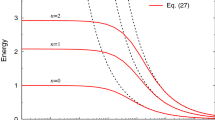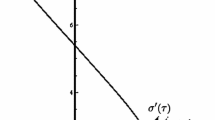Abstract
An exactly solvable relativistic model of a linear oscillator is considered in detail in the presence of a constant external force in both the momentum representation and the relativistic configuration representation. It is found that in contrast to the nonrelativistic case, depending on the magnitude of the force, both discrete and continuous energy spectra are possible. It is shown that in the case of a discrete spectrum, the wave functions in the momentum representation are expressed in terms of the Laguerre polynomials, and in the relativistic configuration representation, in terms of the Meixner–Pollaczek polynomials. Integral and differential–difference formulas are found connecting the Laguerre and Meixner–Pollaczek polynomials. A dynamical symmetry group is constructed.
Similar content being viewed by others
References
L. D. Landau and E. M. Lifshitz, Course of Theoretical Physics, Vol. 3: Quantum Mechanics: Nonrelativistic Theory (1973).
A. I. Baz, Ya. B. Zeldovich, and A. M. Perelomov, Scattering, Reactions and Decay in Non-relativistic Quantum Mechanics, Nauka, Moscow (1971).
M. Moshinsky and Yu. F. Smirnov, The Harmonic Oscillator in Modern Physics (Contemporary Concepts in Physics, Vol. 9), Harwood Academic Publ., Amsterdam (1996).
H. Yukawa, “Structure and mass spectrum of elementary particles. II. Oscillator model,” Phys. Rev., 91, 416–417 (1953).
M. Markov, “On dynamically deformable form factors in the theory of elementary particles,” Nuovo Cimento, 3, 760–772 (1956).
R. P. Feynman, M. Kislinger, and F. Ravndal, “Current matrix elements from a relativistic quark model,” Phys. Rev. D, 3, 2706–2732 (1971).
V. L. Ginzburg and V. I. Man’ko, “Relativistic wave equations with internal degrees of freedom, and partons,” Sov. J. Part. Nucl., 7, 3–20 (1976).
P. N. Bogoljubov, “Equations for bound states (quarks),” Sov. J. Part. Nucl., 3, 144–174 (1972).
T. De, Y. S. Kim, and M. E. Noz, “Radial effects in the symmetric quark model,” Nuovo Cimento A, 13, 1089–1101 (1973).
Y. S. Kim and M. E. Noz, “Group theory of covariant harmonic oscillators,” Am. J. Phys., 46, 480–483 (1978).
Y. S. Kim and M. E. Noz, “Relativistic harmonic oscillators and hadronic structure in the quantum-mechanics curriculum,” Am. J. Phys., 46, 484–488 (1978).
I. Bars, “Relativistic harmonic oscillator revisited,” Phys. Rev. D, 79, 045009, 22 pp. (2009); arXiv: 0810.2075.
D. J. Navarro and J. Navarro-Salas, “Special-relativistic harmoic oscilator modeled by Klein–Gordon theory in anti-de Sitter space,” J. Math. Phys., 37, 6060–6073 (1996).
I. I. Cotaescu, “Geometric models of the relativistic harmonic oscillator,” Internat. J. Modern Phys. A, 12, 3545–3550 (1997); arXiv: physics/9704009.
M. Moshinsky and A. Szczepaniak, “The Dirac oscillator,” J. Phys. A: Math. Gen., 22, L817–L819 (1989).
O. L. de Lange, “Shift operators for a Dirac oscillator,” J. Math. Phys., 32, 1296–1300 (1991).
M. Moreno and A. Zentella, “Covariance, CPT and the Foldy–Wouthuysen transformation for the Dirac oscillator,” J. Phys. A: Math. Gen., 22, L8221–L825 (1989).
R. Lisboa, M. Malheiro, A. S. de Castro, P. Alberto, and M. Fiolhais, “Pseudospin symmetry and the relativistic harmonic oscillator,” Phys. Rev. C, 69, 024319, 15 pp. (2004); arXiv: nucl-th/0310071.
M. Moshinsky, G. Loyola, A. Szczepaniak, C. Villegas, and N. Aquino, “The Dirac oscillator and its contribution to the baryon mass formula,” in: Proceedings of the Rio De Janeiro International Workshop on Relativistic Aspects of Nuclear Physics (Centro Brasileiro de Pesquisas Fisicas, Rio de Janeiro, Brasil, August 28–30, 1989, T. Kodama, K. C. Chung S. J. B. Duarte, and M. C. Nemes, eds.), World Sci., Singapore (1990), pp. 271–308.
R. P. Martinez-y-Romero, H. N. Núñez Yépez, and A. L. Salas-Brito, “Relativistic quantum mechanics of a Dirac oscillator,” Eur. J. Phys., 16, 135–141 (1995); arXiv: quant-ph/9908069.
E. E. Salpeter, “Mass corrections to the fine structure of hydrogen-like atoms,” Phys. Rev., 87, 328–343 (1952).
Z.-F. Li, J.-J. Liu, W. Lucha, W.-G. Ma, and F. F. Schöberl, “Relativistic harmonic oscillator,” J. Math. Phys., 46, 103514, 11 pp. (2005); arXiv: hep-ph/0501268.
K. Kowalski and J. Rembieliński, “Relativistic massless harmonic oscillator,” Phys. Rev. A, 81, 012118, 6 pp. (2010); arXiv: 1002.0474.
V. G. Kadyshevsky, R. M. Mir-Kasimov, and N. B. Skachkov, “Quasi-potential approach and the expansion in relativistic spherical functions,” Nuovo Cimento A, 55, 233–257 (1968).
V. G. Kadyshevskii, R. M. Mir-Kasimov, and N. B. Skachkov, “Three-dimensional formulation of the relativistic two-body problem,” Part. Nucl., 2, 635–690 (1972).
A. D. Donkov, V. G. Kadyshevskii, M. D. Matveev, and R. M. Mir-Kassimov, “Quasipotential equation for a relativistic harmonic oscillator,” Theoret. and Math. Phys., 8, 673–681 (1971).
N. M. Atakishiyev, R. M. Mir-Kassimov, and Sh. M. Nagiyev, “Quasipotential models of a relativistic oscillator,” Theoret. and Math. Phys., 44, 592–603 (1980).
N. M. Atakishiyev, “Quasipotential wave functions of a relativistic harmonic oscillator and Pollaczek polynomials,” Theoret. and Math. Phys., 58, 166–171 (1984).
N. M. Atakishiyev, R. M. Mir-Kasimov, and Sh. M. Nagiyev, “A relativistic model of the isotropic oscillator,” Ann. Phys., 497, 25–30 (1985).
R. M. Mir-Kasimov, Sh. M. Nagiev, and E. Dzh. Kagramanov, Relyativistskiy lineynyy ostsillyator pod deystviem postoyannoy vneshney sily i bilineynaya proizvodyashchaya funktsiya dlya polinomov Pollacheka, Preprint No. 214 [in Russian], SKB IFAN AzSSR, Baku (1987).
E. D. Kagramanov, R. M. Mir-Kasimov, and Sh. M. Nagiyev, “The covariant linear oscillator and generalized realization of the dynamical \(\mathrm{SU}(1,1)\) symmetry algebra,” J. Math. Phys., 31, 1733–1738 (1990).
R. M. Mir-Kasimov, “\(\mathrm{SU}_q(1,1)\) and the ralitivistic oscillator,” J. Phys. A: Math. Gen., 24, 4283–4302 (1991).
Yu. A. Grishechkin and V. N. Kapshai, “Solution of the Logunov–Tavkhelidze equation for the three-dimensional oscillator potential in the relativistic configuration representation,” Russ. Phys. J., 61, 1645–1652 (2019).
N. M. Atakishiyev and K. B. Wolf, “Generalized coherent states for a relativistic model of the linear oscillator in a homogeneous external field,” Rep. Math. Phys., 27, 305–311 (1989).
N. M. Atakishiyev, Sh. M. Nagiyev, and K. B. Wolf, “Wigner distribution functions for a relativistic linear oscillator,” Theoret. and Math. Phys., 114, 322–334 (1998).
S. M. Nagiyev, G. H. Guliyeva, and E. I. Jafarov, “The Wigner function of the relativistic finite-difference oscillator in an external field,” J. Phys. A: Math. Theor., 42, 454015, 10 pp. (2009).
N. M. Atakishiyev, Sh. M. Nagiyev, and K. B. Wolf, “Realization of \(\mathrm{Sp}(2,r)\) by finite-difference operators: the relativistic oscillator in an external field,” J. Group Theory Phys., 3, 61–70 (1995).
E. A. Dei, V. N. Kapshai, and N. B. Skachkov, “Exact solutions of a class of quasipotential equations for a superposition of one-boson exchange quasipotentials,” Theoret. and Math. Phys., 82, 130–138 (1990).
A. A. Atanasov and E. S. Pisanova, “Perturbation theory for relativistic three-dimensional two-particle quasipotential equations,” Theoret. and Math. Phys., 89, 1169–1173 (1991).
A. A. Atanasov and A. T. Marinov, “\(\hbar\)-expansion for bound states described by the relativistic three-dimensional two-particle quasi-potential equation,” Theoret. and Math. Phys., 129, 1400–1407 (2001).
O. P. Solovtsova and Yu. D. Chernichenko, “The resummation \(L\)-factor in the relativistic quasipotential approach,” Theoret. and Math. Phys., 166, 194–209 (2011).
E. D. Kagramanov, R. M. Mir-Kasimov, and Sh. M. Nagiyev, “Can we treat confinement as a pure relativistic effect?”, Phys. Lett. A, 140, 1–4 (1989).
G. Bateman and A. Erdélyi, Higher Transcendental Functions, Vol. 1: The Hypergeometric Function. Legendre Functions, McGraw-Hill, New York (1953).
H. Bateman and A. Erdélyi, Higher Transcendental Functions, Vol. 2, McGraw-Hill, New York–Toronto–London (1953).
R. Koekoek, P. A. Lesky, and R. F. Swarttouw, Hypergeometric Orthogonal Polynomials and Their q-Analogues, Springer, Berlin (2010).
A. O. Barut, “Some unusual applications of Lie algebra representations in quantum theory,” SIAM J. Appl. Math., 25, 247–259 (1973).
I. A. Malkin and V. I. Man’ko, Dynamic Symmetries and Coherent States of Quantum Systems, Nauka, Moscow (1979).
A. O. Barut and R. Raczka, Theory of Group Representations and Applications, Polish Sci. Publ. PWN, Warszawa (1986).
Author information
Authors and Affiliations
Corresponding author
Additional information
Translated from Teoreticheskaya i Matematicheskaya Fizika, 2021, Vol. 208, pp. 481–494 https://doi.org/10.4213/tmf10011.
Appendix
Here, we prove formula (29). We proceed from the recursion relations for the Meixner–Pollaczek and Hermite polynomials [39]
Conflict of interests
The authors declare no conflicts of interest.
Rights and permissions
About this article
Cite this article
Nagiyev, S.N., Mir-Kasimov, R.M. Relativistic linear oscillator under the action of a constant external force. Wave functions and dynamical symmetry group. Theor Math Phys 208, 1265–1276 (2021). https://doi.org/10.1134/S0040577921090087
Received:
Revised:
Accepted:
Published:
Issue Date:
DOI: https://doi.org/10.1134/S0040577921090087




